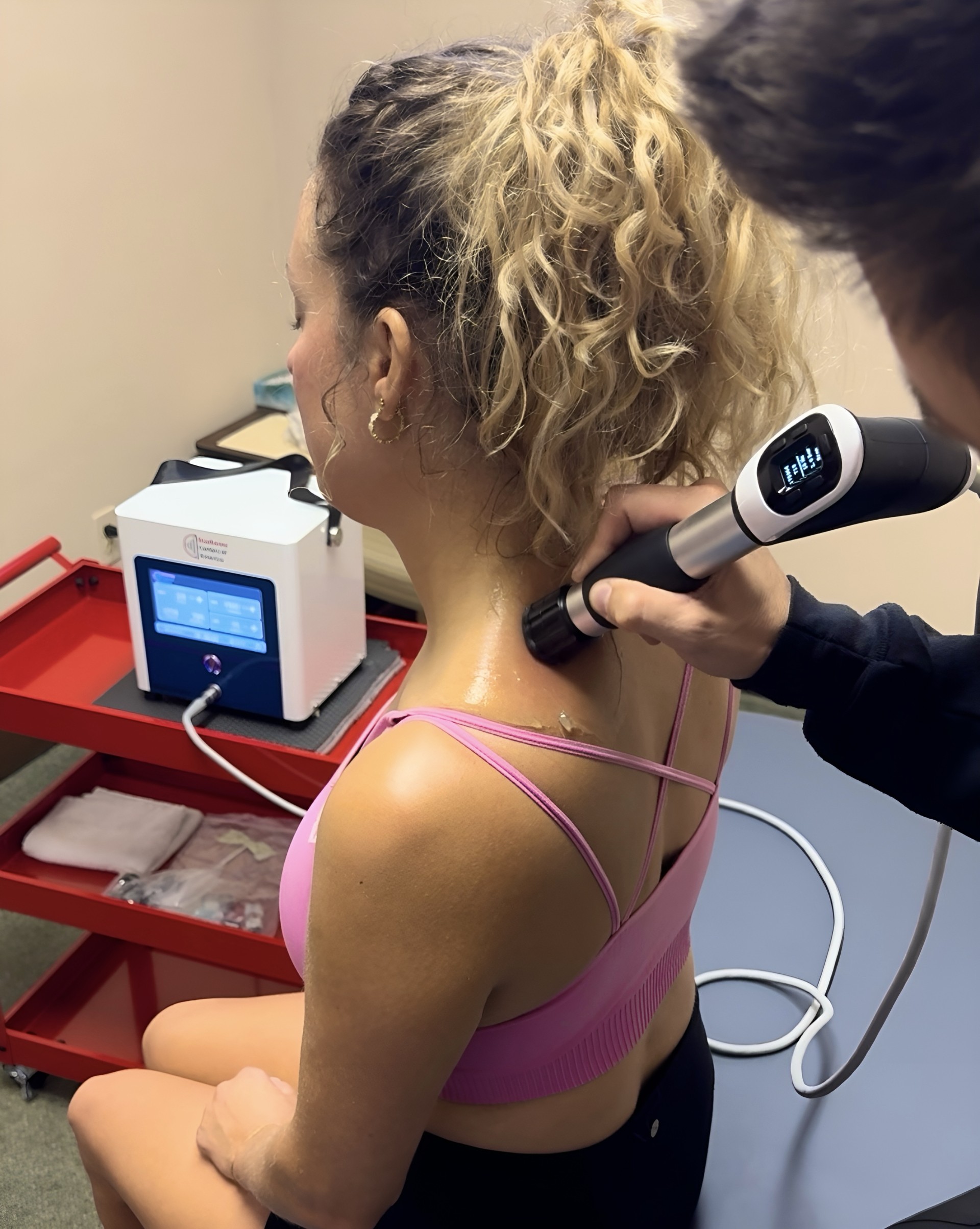Extracorporeal Shockwave Therapy (ESWT) is a non-invasive treatment that uses acoustic waves to promote healing, reduce pain, and improve function in various musculoskeletal conditions. It has gained popularity in orthopedics, sports medicine, and physical rehabilitation for its effectiveness in treating chronic conditions and accelerating recovery.
What Is the Physiology Behind ESWT?
ESWT works by delivering high-energy shockwaves to targeted tissues, initiating several biological processes:
1. Mechanical Stress: The acoustic waves create microtrauma in tissues, stimulating the body’s natural healing response.
2. Neovascularization: ESWT promotes the formation of new blood vessels, improving blood supply and oxygenation to the affected area.
3. Cellular Stimulation:
• Increased Growth Factors: ESWT stimulates the release of growth factors like vascular endothelial growth factor (VEGF) and nitric oxide (NO), which aid tissue repair.
• Stem Cell Activation: Shockwaves activate local stem cells, which enhance tissue regeneration.
4. Pain Reduction:
• Desensitization of Nerves: Shockwaves reduce the sensitivity of pain receptors.
• Calcification Dissolution: ESWT can break down calcifications in tendons or soft tissue, reducing chronic inflammation and pain.
Conditions Treated with ESWT
ESWT is versatile and used for various musculoskeletal conditions, including:
1. Tendonopathies:
• Plantar fasciitis
• Achilles tendinopathy
• Patellar tendinopathy (jumper’s knee)
• Rotator cuff tendinopathy
• Tennis and golfer’s elbow
2. Bone-Related Issues:
• Delayed or non-union fractures
• Stress fractures
• Osteonecrosis
3. Soft Tissue Disorders:
• Calcific shoulder tendinitis
• Myofascial trigger points
4. Other Conditions:
• Chronic low back pain
• Hip bursitis
• Peyronie’s disease (urological application)
What Does the Research Say About ESWT?
Research supports ESWT’s efficacy for several conditions:
1. Plantar Fasciitis: A meta-analysis of randomized controlled trials (RCTs) shows that ESWT significantly reduces pain and improves function in patients with chronic plantar fasciitis. (Rompe et al., 2002; Gerdesmeyer et al., 2008)
2. Tendinopathies: Studies reveal that ESWT is effective in treating chronic tendinopathies, especially calcific tendinitis, where it breaks down calcium deposits and restores mobility. (Delgado et al., 2018)
3. Non-Union Fractures: Research highlights ESWT’s role in stimulating bone healing in non-union fractures, often providing an alternative to surgery. (Wang et al., 2012)
4. Peyronie’s Disease: Urological studies show ESWT improves penile curvature and reduces pain. (Palmieri et al., 2009)
Types of ESWT: Radial vs. Focused
1. Radial Shockwaves:
• Lower energy.
• Spreads over a larger area.
• Used for superficial conditions.
2. Focused Shockwaves:
• Higher energy.
• Penetrates deeper tissues.
• Suitable for deeper musculoskeletal issues and calcifications.
Benefits of ESWT
• Non-Invasive: No surgery or anesthesia required.
• Short Recovery Time: Minimal downtime compared to surgical interventions.
• Cost-Effective: Reduces the need for costly and invasive treatments.
• Evidence-Based: Backed by clinical research for several chronic conditions.
Safety and Side Effects
ESWT is generally safe, with minor side effects such as:
• Redness or swelling at the treatment site.
• Mild discomfort during or after the procedure.
• Temporary bruising.
These effects typically resolve within a few days.
Who Should Avoid ESWT?
Contraindications include:
• Active infections or open wounds near the treatment area.
• Blood clotting disorders or anticoagulant use.
• Pregnancy.
• Patients with pacemakers or other implanted devices near the treatment site.
How Does ESWT Fit Into Rehabilitation?
At Back to You Physical Therapy and Rehabilitation, ESWT is part of a comprehensive approach to care. It is combined with:
• Manual therapy.
• Strengthening exercises.
• Neuromuscular re-education.
• Gait and postural retraining.
Conclusion
Extracorporeal Shockwave Therapy is a scientifically backed, innovative treatment for chronic pain and musculoskeletal disorders. Its ability to stimulate healing and reduce pain non-invasively makes it a powerful tool for physical therapists, chiropractors, and sports medicine specialists. Whether addressing tendinopathies, fractures, or chronic pain syndromes, ESWT offers a solution that promotes recovery and reduces the need for surgical interventions. Shockwave is offered at our Michigan locations.
Bibliography
1. Rompe, J. D., et al. (2002). “Effectiveness of shockwave therapy for chronic plantar fasciitis.” The American Journal of Sports Medicine.
2. Gerdesmeyer, L., et al. (2008). “Extracorporeal shock wave therapy for the treatment of chronic calcifying tendonitis of the rotator cuff: a randomized controlled trial.” JAMA.
3. Wang, C. J., et al. (2012). “Extracorporeal shockwave therapy for delayed union and nonunion fractures: a systematic review.” International Journal of Surgery.
4. Delgado, G., et al. (2018). “Radial shockwave therapy for tendinopathies: a systematic review and meta-analysis.” Physical Therapy Reviews.
5. Palmieri, A., et al. (2009). “Penile low-intensity shock wave therapy: an overview.” Journal of Sexual Medicine.

